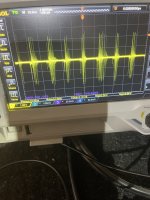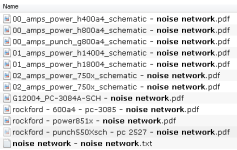Well that was fun freezing parts but unfortunately not conclusive. Still out of the heatsink. Did it’s normal no noise after 30 seconds. Froze all the spots maybe a square inch at a time. Thought I narrowed it down to 2-3 spots that kept the noise going but couldn’t really duplicate - the noise stops, refroze, nothing, still silent. Heated the board, nothing. Refroze suspected spots, nothing.
Cooling the hot mpsa06/56 didn’t make a difference in noise or current. The 6521’s - heat dropped idle current, cold increased. Touching 6521 leads with a finger didn’t change idle current but I only had the clamp meter on it which only measures in 10ths.
If only one speaker is hooked up to say the front channels touching the rear channels 6521s alters the noise.
How does it go from continuous noise in heatsink to 30sec out of it?? So many mysteries.
Cooling the hot mpsa06/56 didn’t make a difference in noise or current. The 6521’s - heat dropped idle current, cold increased. Touching 6521 leads with a finger didn’t change idle current but I only had the clamp meter on it which only measures in 10ths.
If only one speaker is hooked up to say the front channels touching the rear channels 6521s alters the noise.
How does it go from continuous noise in heatsink to 30sec out of it?? So many mysteries.
Time to call Mulder and Scully?
Did you try this in low-pass mode to eliminate the preamp (as much as possible) from the equation?
Did you try this in low-pass mode to eliminate the preamp (as much as possible) from the equation?
I'm sure you saw this thread and it seems different from your problem but...
https://www.diyaudio.com/community/threads/rockford-punch-600-a4-noise.387075/post-7044844
https://www.diyaudio.com/community/threads/rockford-punch-600-a4-noise.387075/post-7044844
I did the heat/cool in all pass because when it was still in the heatink low pass eliminates the noise.
That sounds like a preamp problem if low-pass completely solves the problem. I thought it was only slightly reducing the noise.
What's the resistance from the RCA shields to the primary ground terminal? No RCAs plugged in?
What's the resistance from the RCA shields to the primary ground terminal? No RCAs plugged in?
Interesting ! Out of the heatsink I reverted back to battery @12.5ish volts. I’ll switch back to the power supply or maybe add a AA in series to get above 13v to see if I can replicate that rail trace. There is hope yet. Great find Perry.
Used psu again at 14.4v. Noise is continuous outside of heating. So voltage had something to do with it maybe. Found noise on rail voltage, attached
Ok… so, found wonky 2-4 channel switch. Idle current would bounce all over when the post was wiggled around in place and the noise would warble when doing so as well. Removed and temporarily shorted the pads to select 2 channel mode. Ultimately noise still there may explain some stuff with noise changing on physically putting pressure on board and just the randomness of it.
Removed r52/53. Speaker noise gone. The noise on rail is still there. Rail noise is normal ?
Going to reset bias once I get new switches in and retest.
Ok… so, found wonky 2-4 channel switch. Idle current would bounce all over when the post was wiggled around in place and the noise would warble when doing so as well. Removed and temporarily shorted the pads to select 2 channel mode. Ultimately noise still there may explain some stuff with noise changing on physically putting pressure on board and just the randomness of it.
Removed r52/53. Speaker noise gone. The noise on rail is still there. Rail noise is normal ?
Going to reset bias once I get new switches in and retest.
Attachments
Where was the scope ground connected?
So, the entire noise problem (other than the switch) was the PS network?
Is there a ground connection to the heatsink?
So, the entire noise problem (other than the switch) was the PS network?
Is there a ground connection to the heatsink?
This was all done outside the heat sink so no connection at all to it ground or otherwise.
Scope test signal ground connected to psu case. Probe ground to speaker (non bridged terminal) ground. Once it’s back in the heatsink I’ll try again
It seems yes, that resistor/cap network was responsible for the noise. This is a board 3085 600.4…. The 500x pc3084 has a place on the board for the resistor/cap but is missing. Maybe someone at Fosgate experimented for a short while.
Scope test signal ground connected to psu case. Probe ground to speaker (non bridged terminal) ground. Once it’s back in the heatsink I’ll try again
It seems yes, that resistor/cap network was responsible for the noise. This is a board 3085 600.4…. The 500x pc3084 has a place on the board for the resistor/cap but is missing. Maybe someone at Fosgate experimented for a short while.
Ground the scope to the ground terminal of the rail cap and probe the other terminal of the cap. Use the short probe ground clip.
There were about 3 or 4 diagrams that show the network but they show them as not used.
There were about 3 or 4 diagrams that show the network but they show them as not used.
What a frustrating experience. Replaced all 3 switches. Left r52/53 out. Powered it up first time since 2 weeks ago and noise is still there.
At one point I thought it was the gain pots so I removed them and shorted pins 1-2 for each channel which if I’m reading the schematic right shorts the inverting input to output for max gain … still there
Eventually noise went away which points back to heat. Had at it with the freeze can again. May be the regulators…. When frozen nose comes back. Letting them warm up on their own for a few minutes, or manually with the heat gun and noise goes away. Those are easy enough to replace….
At one point I thought it was the gain pots so I removed them and shorted pins 1-2 for each channel which if I’m reading the schematic right shorts the inverting input to output for max gain … still there
Eventually noise went away which points back to heat. Had at it with the freeze can again. May be the regulators…. When frozen nose comes back. Letting them warm up on their own for a few minutes, or manually with the heat gun and noise goes away. Those are easy enough to replace….
Oh by the way Perry I flipped the board over - measuring the rails at the bulk caps showed way less noise - about 1v peak-peak.
Measuring the regulator output when hot, at one of the opamps, and ignoring the switching noise because of grounding issues, showed a very thick fuzzy base line (maybe 0.5-1v of p-p fuzz) that got thin as a they warmed up.
Measuring the regulator output when hot, at one of the opamps, and ignoring the switching noise because of grounding issues, showed a very thick fuzzy base line (maybe 0.5-1v of p-p fuzz) that got thin as a they warmed up.
Shorting 1-2 makes the op-amp a buffer. In = out. No gain. 2-3 would be maximum gain. Confirm by looking at the input vs output signals.
Is the board darkened around the terminals of the regulators?
Is the board darkened around the terminals of the regulators?
Not particularly but the barcode sticker in that area looked a little toasted
Odd how that works … usually heat in active elements is a bad thing right ? In this failure mode heat makes it work better apparently!
Odd how that works … usually heat in active elements is a bad thing right ? In this failure mode heat makes it work better apparently!
Some of those boards get cooked to a point where they could become conductive. They show definite signs of heat stress well before that point.
Does carefully heating or cooling only one of the regulators (masking the other) make a difference?
Could it be that you're heating some of the capacitors in that area?
Or the board?
Does carefully heating or cooling only one of the regulators (masking the other) make a difference?
Could it be that you're heating some of the capacitors in that area?
Or the board?
Well the heat I can’t really control as the nozzle is something like 1.5” diameter… not the smd rework type of gun. Letting it warm back up on its own does the same thing though and the radiant heat doesn’t really affect the area that quickly without the cover over it
However the cooling is easily controlled with the straw. Can’t remember which but yes cooling one regulator seemed to make it worse then the other. I’ll repeat the experiment and pay closer attention and tape/insulate the surroundings
However the cooling is easily controlled with the straw. Can’t remember which but yes cooling one regulator seemed to make it worse then the other. I’ll repeat the experiment and pay closer attention and tape/insulate the surroundings
Yep … just bent some thin cardboard in an U shape …. The negative regulator u4 appears to be the culprit. Cold = noise, hot = quiet.
- Home
- General Interest
- Car Audio
- Fosgate 600 4 channel

